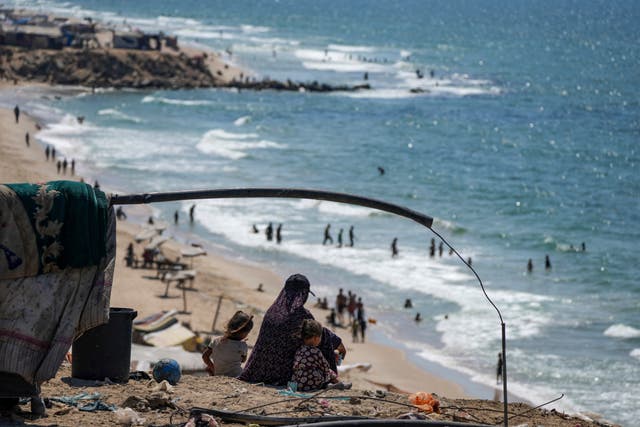Egypt, the key mediator in ceasefire talks between Israel and Hamas, expressed scepticism on Wednesday as more details emerged of the proposal meant to bridge gaps in talks.
Negotiations are expected to resume in Cairo on Thursday.
The challenges around the so-called bridging proposal appear to undermine the optimism of an imminent agreement that US Secretary of State Antony Blinken carried into his latest visit to the Middle East.
Diplomatic efforts had redoubled as fears grow of a wider regional war after the recent targeted killings of Hamas and Hezbollah leaders, both blamed on Israel and threats of retaliation

President Joe Biden spoke with Israeli Prime Minister Benjamin Netanyahu on Wednesday, the White House said, without immediately giving details on what was said.
Officials in Egypt, in its unique role as both a mediator and affected party since it borders Gaza, told The Associated Press that the Hamas militant group would not agree to the bridging proposal for a number of reasons — ones in addition to the long-held wariness over whether a deal would truly remove Israel forces from Gaza and end the war.
One Egyptian official said the bridging proposal requires the implementation of the deal’s first phase, which has Hamas releasing the most vulnerable civilian hostages captured in its October 7 attack that sparked the war.
Parties during the first phase would negotiate the second and third phases with no “guarantees” to Hamas from Israel or mediators.
“The Americans are offering promises, not guarantees,” the official said. “Hamas won’t accept this, because it virtually means Hamas will release the civilian hostages in return for a six-week pause of fighting with no guarantees for a negotiated permanent ceasefire.”
He also said the proposal does not clearly say Israel will withdraw its forces from two strategic corridors in Gaza, the Philadelphi corridor alongside Egypt and the Netzarim corridor east to west across the territory.
Israel offers to downsize its forces in the Philadelphi corridor, with “promises” to withdraw from the area, he said.
“This is not acceptable for us and of course for Hamas,” the Egyptian official said.
A second Egyptian official said there were few chances for a breakthrough since Israel refuses to commit to a complete withdrawal from Gaza in the deal’s second phase.
The official said Israel also insists on keeping its forces in the Philadelphi corridor and having full control of the Netzarim corridor.
He also said Egypt told the US and Israel that it would not reopen the Rafah crossing into Gaza, which borders Egypt and is a crucial entry point for humanitarian aid, without the complete withdrawal of Israeli forces from the Palestinian side and from the Philadelphi corridor.

Mediators are scheduled to meet on Thursday and Friday in Cairo for more talks on the proposal before submitting it officially to Hamas.
Hamas political official Bassem Naim said on Tuesday that the bridging proposal adopted several new demands from Mr Netanyahu, including that Israeli forces remain in Rafah, Philadelphi and Netzarim and searches of displaced Palestinians returning to northern Gaza.
Israel has said the searches are necessary to find militants.
Mr Naim said the proposal also includes unspecified changes to the exchange of hostages held in Gaza for Palestinians imprisoned in Israel and does not guarantee that a ceasefire would remain in place during negotiations on the transition from the deal’s first phase to the second.
In previous versions of the plan, the second phase would entail a permanent ceasefire, full withdrawal of Israeli forces from Gaza and the release of remaining male hostages, both civilians and soldiers
Mr Blinken, after his meetings in Egypt and in Qatar, another mediator, told journalists that the bridging proposal is “very clear on the schedule and the locations of (Israeli military) withdrawals from Gaza,” but no details on either have emerged.
Mr Blinken also said that because Israel has accepted the proposal, the focus turns to doing everything possible to “get Hamas on board”.
Egypt’s state-run Al-Ahram daily reported that Mr Blinken received a “clear Egyptian demand for the US to work towards a well-framed deal with clear deadlines and clear objectives to encourage Hamas to sign the deal”.
However, there is scepticism, along with fatigue, among many in Israel about Mr Netanyahu’s commitment to securing a ceasefire deal.
“As long as the entire group of professional negotiators believes that Netanyahu is scuttling a deal, there won’t be any confidence,” commentator Nadav Eyal wrote in the daily newspaper Yedioth Ahronoth. “And, in the absence of confidence, Israeli society will remain torn and shattered.”
The war in Gaza, now in its 10th month, has caused widespread destruction and forced the vast majority of Gaza’s 2.3 million residents to flee their homes, often multiple times. Aid groups fear the outbreak of polio and other diseases.
The October 7 attack by Hamas and other militants killed some 1,200 people, mostly civilians. Over 100 hostages were released during last year’s cease-fire in exchange for Palestinians imprisoned in Israel. Hamas is still believed to be holding around 110 hostages, though Israeli authorities estimate around a third are dead.
Six bodies of hostages were recovered this week in Gaza.
Israel’s retaliatory offensive has killed over 40,000 Palestinians, according to Gaza’s Health Ministry, which does not distinguish between civilians and combatants in its count.




Why are you making commenting on The Herald only available to subscribers?
It should have been a safe space for informed debate, somewhere for readers to discuss issues around the biggest stories of the day, but all too often the below the line comments on most websites have become bogged down by off-topic discussions and abuse.
heraldscotland.com is tackling this problem by allowing only subscribers to comment.
We are doing this to improve the experience for our loyal readers and we believe it will reduce the ability of trolls and troublemakers, who occasionally find their way onto our site, to abuse our journalists and readers. We also hope it will help the comments section fulfil its promise as a part of Scotland's conversation with itself.
We are lucky at The Herald. We are read by an informed, educated readership who can add their knowledge and insights to our stories.
That is invaluable.
We are making the subscriber-only change to support our valued readers, who tell us they don't want the site cluttered up with irrelevant comments, untruths and abuse.
In the past, the journalist’s job was to collect and distribute information to the audience. Technology means that readers can shape a discussion. We look forward to hearing from you on heraldscotland.com
Comments & Moderation
Readers’ comments: You are personally liable for the content of any comments you upload to this website, so please act responsibly. We do not pre-moderate or monitor readers’ comments appearing on our websites, but we do post-moderate in response to complaints we receive or otherwise when a potential problem comes to our attention. You can make a complaint by using the ‘report this post’ link . We may then apply our discretion under the user terms to amend or delete comments.
Post moderation is undertaken full-time 9am-6pm on weekdays, and on a part-time basis outwith those hours.
Read the rules here